Scorpions in Texas are a fascinating and often misunderstood part of the state’s diverse ecosystem. With Texas spanning deserts, grasslands, forests, and mountains, it provides the perfect environment for a wide range of scorpion species to thrive. These arachnids can be found in both wild habitats and urban areas, often hiding under rocks, logs, or debris.
Although many people fear them, most scorpions in Texas pose little threat to humans. Their stings are usually no more severe than a bee sting, though identification remains important—especially in areas where venomous species may be present. Knowing what to look for helps avoid unnecessary encounters and provides insight into their behaviors and habitats.
This article explores 21 unique scorpions in Texas, offering detailed identification tips and images to help you recognize them. Ideal for nature enthusiasts, residents, hikers, or campers, this guide will give you a deeper appreciation for these resilient and resourceful creatures found throughout the state.
Different Types of Scorpions in Texas
Diplocentrus lindo
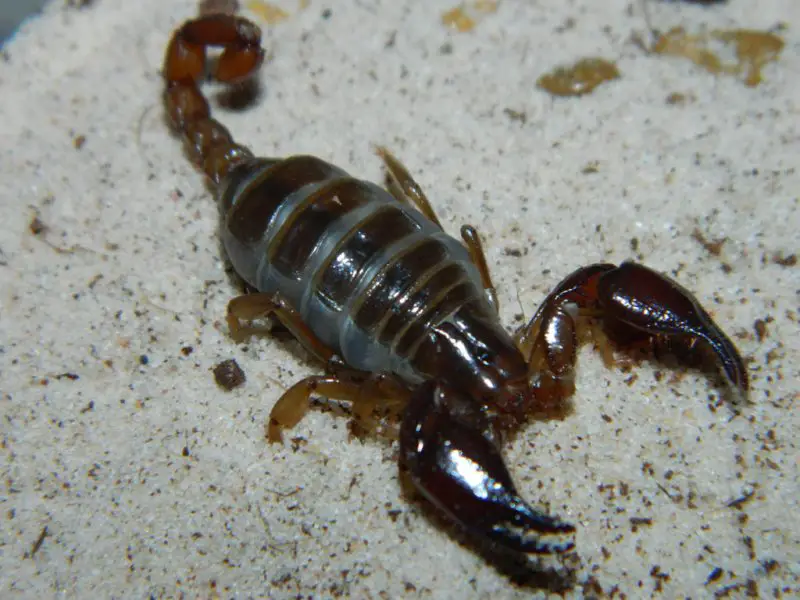
Diplocentrus lindo, or the Trans-Pecos smoothclaw scorpion, is native to the arid regions of West Texas, particularly in the Trans-Pecos area. These scorpions are a deep maroon color, giving them a distinctive appearance compared to many lighter-colored species. Although their sting can be painful, it is usually not medically significant, causing only mild redness and irritation in most cases.
They are ground-dwelling burrowers, creating tunnels in sandy or loose soils where they spend much of the day hidden from predators and the heat. At night, they emerge to hunt, using stealth and patience to ambush small insects and other invertebrates. Their preferred habitats include deserts and dry, rocky slopes.
Despite their defensive sting, Trans-Pecos smoothclaw scorpions are not considered dangerous and are generally non-aggressive unless provoked. They contribute to the local ecosystem by helping control insect populations, and their elusive nature makes them less frequently seen compared to more widespread species like Centruroides vittatus.
Chihuahuanus coahuilae
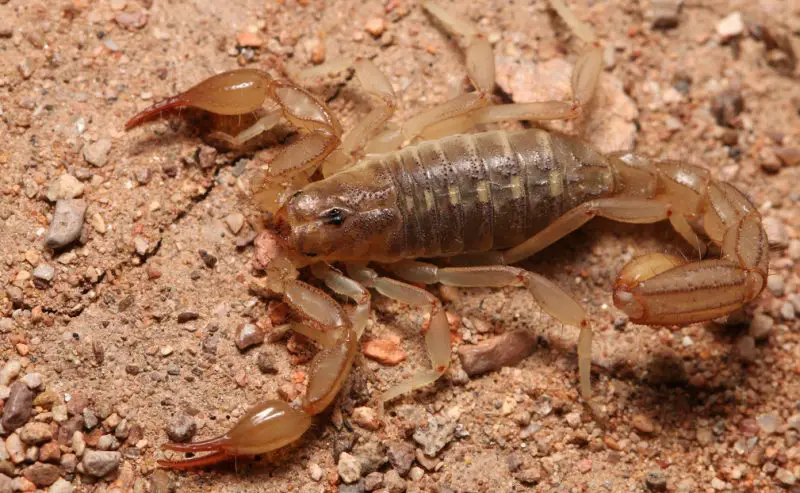
Chihuahuanus coahuilae, the lesser stripetail scorpion, is found throughout various ecosystems in Texas, ranging from sandy deserts to mixed woodlands. This species exhibits a noticeable sexual dimorphism, with females typically reaching 5.5 centimeters while males are smaller at about 3.5 centimeters. Their coloration blends well with their surroundings, helping them remain hidden from both predators and prey.
These scorpions are proficient burrowers, using their claws and body to dig into loose soil or sand to escape the harsh daytime heat. When threatened, they often choose to flee rather than fight, although they may raise their tails in a defensive posture if escape isn’t an option. Their reclusive behavior makes encounters with humans relatively uncommon.
Lesser stripetail scorpions feed primarily on insects and other small arthropods, using a quick sting to subdue prey. They play a beneficial role in their native habitats by keeping pest populations in check. In Texas, they can be encountered in both natural environments and occasionally in yards with loose, dry soil.
Vaejovis intermedius

Vaejovis intermedius, commonly referred to as the intermediate scorpion, is native to rocky and mountainous areas of Texas. This species is a true rock-dweller, preferring to hide in crevices, under stones, and along cliff faces. Unlike many scorpions, they do not burrow and instead rely on natural rock formations for shelter and hunting grounds.
They are medium-sized, reaching up to 6 centimeters in length, and are known for their quick movements and defensive temperament. Their venom is thick and milky, and while not life-threatening, it causes a painful sting that can result in localized swelling and discomfort. Due to their reclusive nature and camouflage, they are not easy to spot, but where one is found, others are often nearby.
Intermediate scorpions hunt by night, preying on small insects and other arthropods. Their aggressive nature means they do not hesitate to sting if disturbed. In Texas, they are most likely to be encountered by hikers or climbers exploring rocky terrain, especially in areas with exposed cliff faces and boulder fields.
Maaykuyak waueri
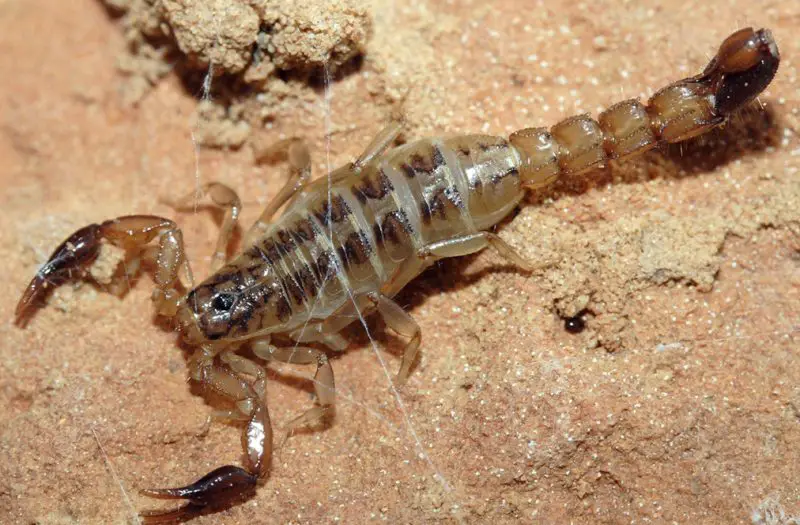
Maaykuyak waueri, commonly known as Wauer’s scorpion, is a small member of the Vaejovidae family that resides primarily in southern Texas. Females reach about 2.5 centimeters in length, while males are slightly smaller at approximately 1.75 centimeters. These scorpions are relatively inconspicuous due to their size, but they can be spotted in suitable habitats during nighttime activity.
They are typically found in semi-arid environments, where they seek shelter under rocks, debris, or loose soil during the heat of the day. Their presence in Texas is largely confined to the southern regions, where the climate provides the dry, warm conditions they prefer. Despite their limited size, Wauer’s scorpions exhibit the classic solitary and nocturnal behaviors characteristic of most scorpion species.
Although their sting can be uncomfortable and causes a sharp pain, it is not considered dangerous to humans. They use their venom primarily to subdue small prey such as insects. Their shy nature means they are unlikely to sting unless directly threatened or mishandled, and they typically avoid human contact.
Centruroides vittatus
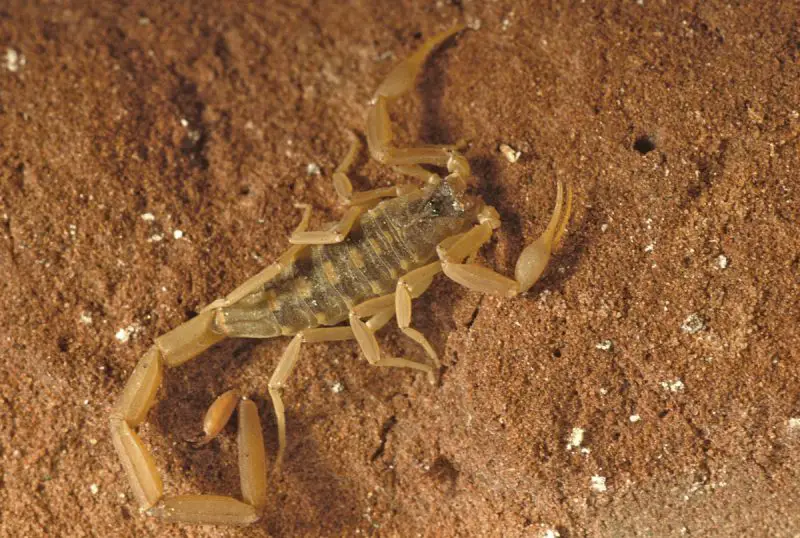
Centruroides vittatus, commonly known as the striped bark scorpion, is one of the most widespread and frequently encountered scorpion species in Texas. This medium-sized arachnid typically reaches about 7 centimeters in length and is easily recognizable by its pale yellow body adorned with two distinct dark stripes running down its back. Its coloration helps it blend into its environment, providing camouflage from predators and aiding in ambush hunting.
These scorpions inhabit a broad range of environments including deserts, woodlands, and suburban areas. In Texas, they are often discovered beneath rocks, within crevices, inside barns and sheds, and occasionally in homes. Though they have some climbing ability and are considered semi-arboreal, they spend most of their time on the ground, especially during the night when they actively hunt for small insects and other invertebrates.
Striped bark scorpions are nocturnal hunters that rely on their sensitive hairs and vibration detection to locate prey. While their sting can be painful, it is generally not dangerous to humans unless an allergic reaction occurs. Their adaptable nature and preference for sheltered hiding spots make them one of the most common scorpions found near human dwellings in Texas.
Pseudouroctonus reddelli

Pseudouroctonus reddelli, known as the Texas cave scorpion, is a secretive species often found in limestone-rich areas across Texas. Adults possess the fascinating ability to fluoresce under UV light, making them easier to spot with a blacklight. These scorpions are active at night and are frequently seen hiding in fallen logs, decaying plant matter, and sometimes even inside houses near rural limestone formations.
Their natural habitat includes grottos, caves, and other karst formations, where they shelter during the day and emerge at night to forage. In Texas, they are particularly associated with cave systems and rocky outcrops, but may also wander into yards or basements in areas near their native habitat. Despite their eerie appearance, they tend to be non-aggressive and shy.
Texas cave scorpions are opportunistic feeders, preying on small arthropods and insects. They use their pincers to grasp prey and immobilize it with a venomous sting. Though their sting can be irritating, it is not considered dangerous. Their ability to adapt to both natural and semi-urban environments makes them an intriguing species to observe.
Diplocentrus whitei
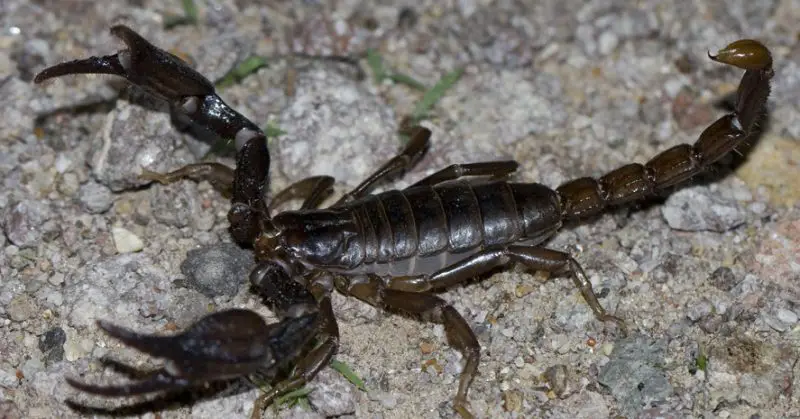
Diplocentrus whitei, or the Big Bend scorpion, is the largest species in the Diplocentrus genus and is native to southern Texas, particularly in the Big Bend region. Adults can grow up to nearly 3 inches (2.95 inches) in length and have a robust, dark reddish-brown body that blends well with rocky and desert terrains. This scorpion is known for its powerful pincers, which can inflict a sharp pinch capable of drawing blood.
Unlike many scorpions that rely primarily on their venom, the Big Bend scorpion uses its strong claws to overpower prey. Although it does possess venom, its sting is considered mild and not harmful to humans. Their size and strength make them efficient hunters, primarily feeding on insects and other arthropods.
These scorpions are very active and are most often encountered at night when they emerge from beneath rocks and logs to hunt. They thrive in desert and rocky habitats, particularly in remote areas with limited human disturbance. Despite their size and strength, they are not aggressive and will retreat when given the opportunity.
Chihuahuanus crassimanus
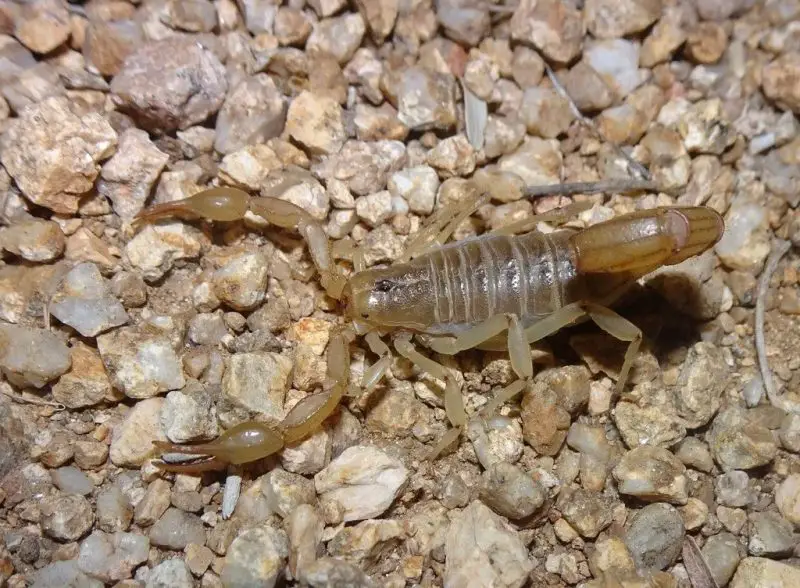
Chihuahuanus crassimanus, known as the thick-handed scorpion, is a rarely observed species in Texas due to its elusive nature and nocturnal habits. Its sandy-colored body provides excellent camouflage against arid soil and desert landscapes, making it difficult to spot even when active. These scorpions are adapted to remain hidden during the daytime and become active only after dark.
In Texas, their habitat includes dry deserts and scrubland, where they find shelter in cracks, under stones, or in loose soil. Because of their low visibility and secretive behavior, only a few verified sightings have been recorded within the state. Their presence is more likely in remote areas where natural desert conditions prevail.
Though specific details about their venom are limited, they are presumed to be similar to related species—capable of a sting that may be mildly irritating but not medically significant. Their primary diet consists of small insects and other invertebrates they can overpower during their nightly hunts.
Pseudouroctonus brysoni
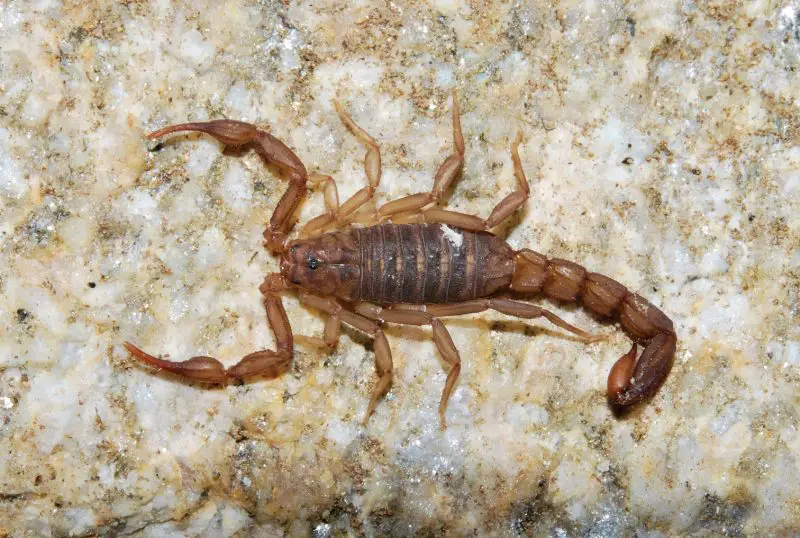
Pseudouroctonus brysoni is a scorpion species endemic to Texas and part of the Vaejovidae family. Males typically grow to around 2.65 centimeters and are most commonly observed during the late summer months, particularly in August. These scorpions are relatively uncommon and not widely distributed across the state, with sightings usually limited to specific habitats.
They prefer dry, rocky environments and may be found hiding under debris, in crevices, or in areas with dead vegetation. Like many other scorpions, they are nocturnal and tend to avoid daylight exposure by seeking shelter in secure microhabitats. Their behaviors are consistent with other ground-dwelling species that rely on concealment to avoid predators and extreme temperatures.
Although little is known about the potency of their venom, it is not considered a serious threat to humans. Their sting may cause temporary discomfort but is unlikely to produce severe reactions. Their limited range and shy demeanor make encounters with Pseudouroctonus brysoni relatively rare.
Chihuahuanus russelli
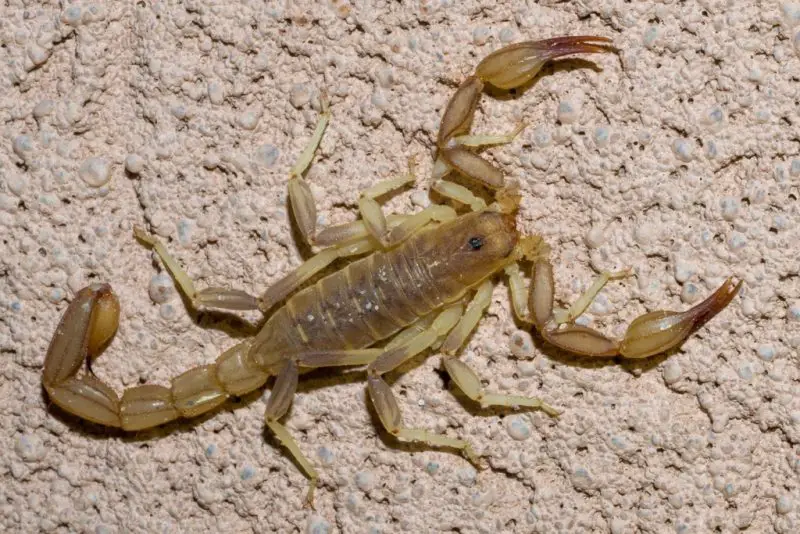
Chihuahuanus russelli, or Russell’s scorpion, is a medium-sized scorpion species that can grow up to 5.5 centimeters in length. It is easily identified by its red-tipped pincers and long, slender tail. The body is typically a uniform shade of brown to yellow, lacking any significant markings, which helps it blend into desert and grassland habitats.
In Texas, Russell’s scorpions are found burrowing beneath rocks and debris in arid environments, including both deserts and grassy plains. They often create their burrows at the base of plants or under natural ground cover, where the soil is loose enough to dig. Their burrowing behavior allows them to escape the heat and predators during the day, emerging only at night to hunt.
These scorpions are opportunistic feeders, preying on small insects and other invertebrates. Though not aggressive, they may assume a defensive posture if threatened. Their sting is painful but not dangerous to most humans. Russell’s scorpions play an important role in local ecosystems by helping to control insect populations.
Pseudouroctonus apacheanus
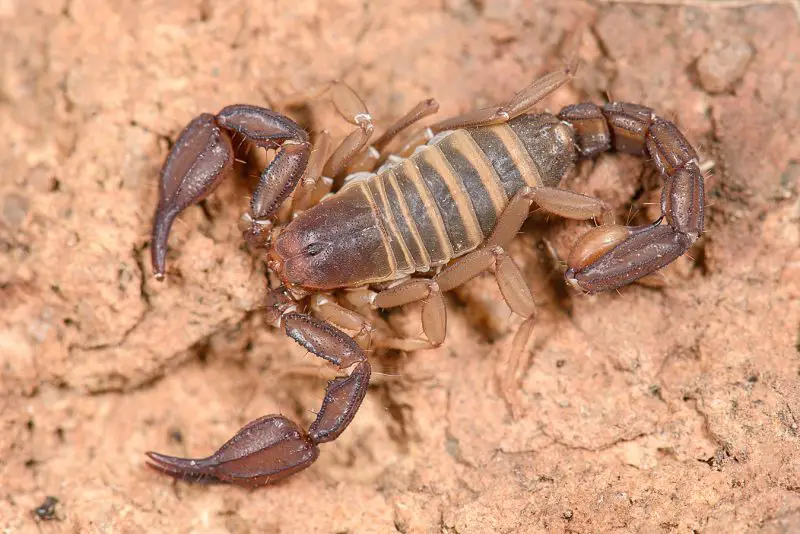
Pseudouroctonus apacheanus is a highly elusive and rarely observed scorpion species known from areas near Del Rio, Texas. This secretive creature is a member of the Vaejovidae family and has adapted to a burrowing lifestyle, which contributes to its infrequent sightings in the wild. Its preference for secluded, undisturbed environments makes it challenging to study or encounter casually.
These scorpions are notably shy and nervous, remaining hidden during daylight hours. Like many burrowing species, they seek refuge underground or under natural debris, only emerging at night to hunt. Their activity is mostly nocturnal, and they rely on stealth and surprise to capture prey such as insects and other small arthropods.
Although limited information exists about their venom or behavior toward humans, their reclusive nature suggests minimal risk. They play a valuable role in the local ecosystem by helping to control insect populations, and their rarity adds to the biodiversity significance of the region around Del Rio.
Vaejovis chisos
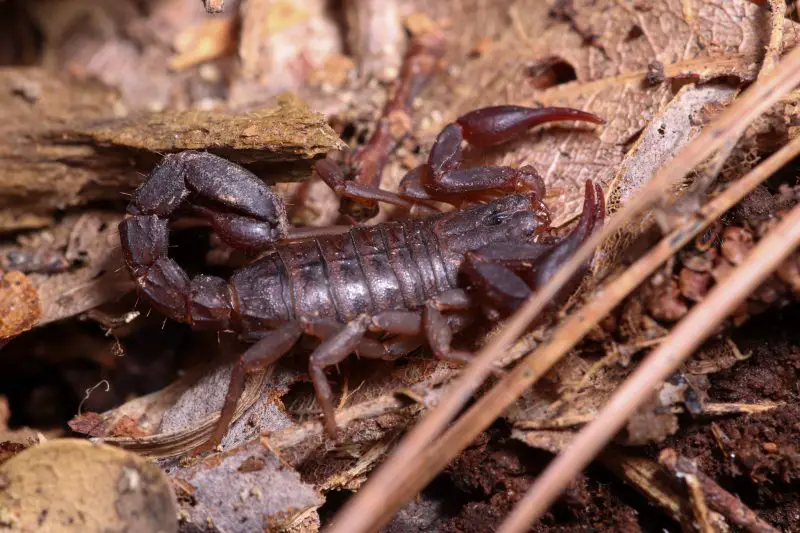
Vaejovis chisos is a small scorpion species endemic to Texas, specifically found in the Chisos Mountains and Brewster County. It is a member of the Vaejovidae family and inhabits diverse terrains such as canyons, forested areas, and even caves, showcasing its adaptability to different microhabitats in the mountainous desert environment.
This species remains relatively small, growing to just about 2.75 centimeters in length. Despite its tiny stature, it is an active predator of insects and small arthropods. Due to its size and secretive nature, sightings of this scorpion are uncommon unless one is actively searching under rocks or within crevices.
Vaejovis chisos is not considered dangerous to humans. Like most scorpions in its family, its sting may be mildly irritating but is not medically significant. Its presence is valuable for biodiversity and pest control in its native ecosystem.
Hadrurus arizonensis
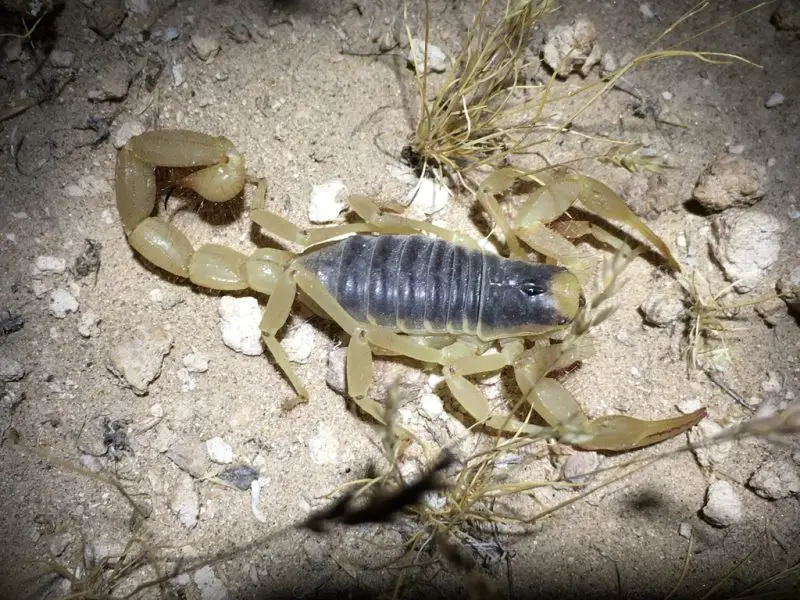
Hadrurus arizonensis, widely known as the giant desert hairy scorpion, is one of the largest scorpions in North America, reaching up to 5.5 inches (14 cm) in length. It belongs to the Hadruridae family and is native to the arid deserts of the southwestern United States, including parts of Texas.
This species is yellow with a dark dorsal stripe and has a body covered in fine brown hairs, which give it a “hairy” appearance. Its powerful pincers and large body allow it to prey on a wide range of animals, including other scorpions, small snakes, lizards, and large insects. It constructs deep burrows for shelter and is typically found under large rocks during the day.
Despite its formidable appearance, the venom of Hadrurus arizonensis is not potent, with a sting comparable to that of a honeybee. While it can cause localized pain and swelling, it is only dangerous to those who are allergic. As with bee stings, severe reactions require prompt medical attention.
Paravaejovis puritanus
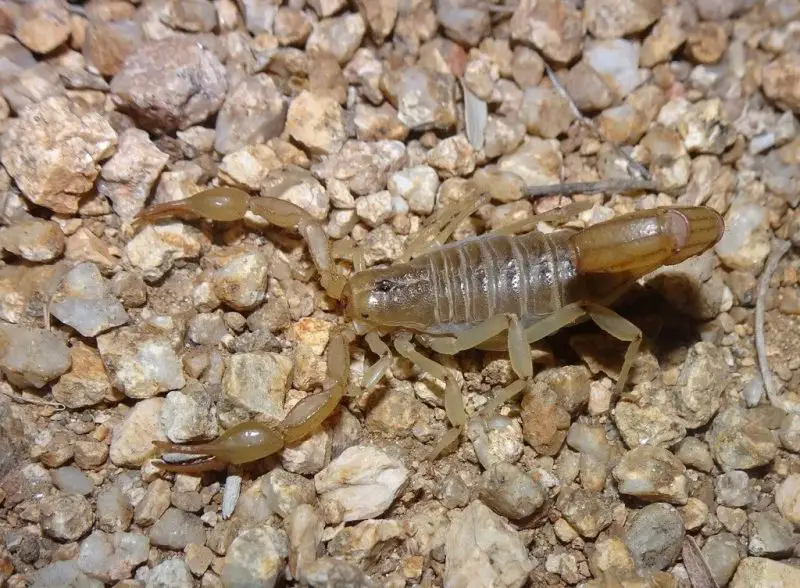
Paravaejovis puritanus is a nocturnal and burrowing scorpion belonging to the Vaejovidae family, found in arid regions where it stays hidden from view during daylight hours. Its behaviors make it difficult to observe in the wild, as it primarily emerges at night to hunt.
This species is a burrow-dweller, preferring loose, dry soils where it can construct shelters that protect it from daytime heat and predators. When active, it feeds on a variety of arthropods, playing a beneficial role in the ecosystem by helping control pest populations.
While its sting can be painful and uncomfortable, symptoms typically subside within 72 hours. Treatment includes cleaning the site, applying a cold compress to reduce swelling, and using over-the-counter pain relievers. For most individuals, the sting is not dangerous, though care should always be taken with young children or those with allergies.
Paruroctonus utahensis
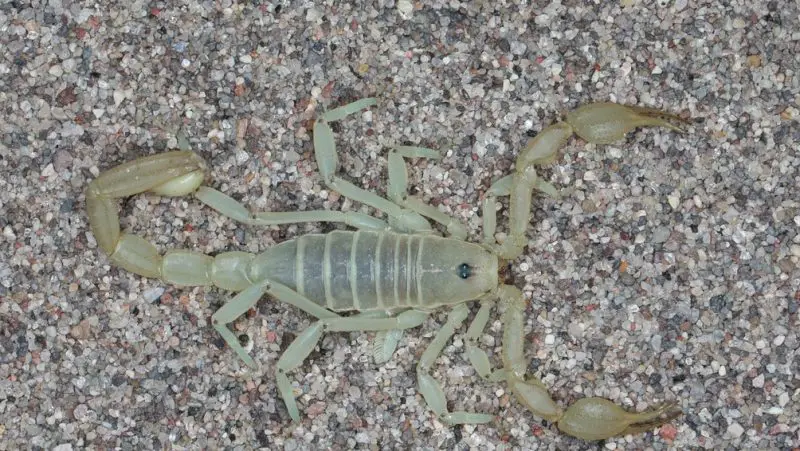
Paruroctonus utahensis, commonly known as the Eastern Sand Scorpion, is well-adapted to sandy desert environments, particularly in the El Paso region where it is one of the most dominant species. These scorpions are characterized by their yellow to light brown coloration, which provides effective camouflage against sandy substrates. They are members of the Vaejovidae family.
One of their notable features includes swollen pincers and bristle-covered legs, both of which aid in navigating and hunting within loose sand. They are skilled burrowers and typically establish their shelters at the base of plants on sand dunes. These microhabitats offer protection from predators and temperature extremes, allowing them to remain hidden during the hot daylight hours.
Eastern Sand Scorpions emerge at night to hunt insects and other arthropods. Though they may appear intimidating, their sting is not considered medically significant to humans. Their widespread presence and dominance in sandy areas make them a common sight for those exploring arid regions of western Texas.
Centruroides sculpturatus
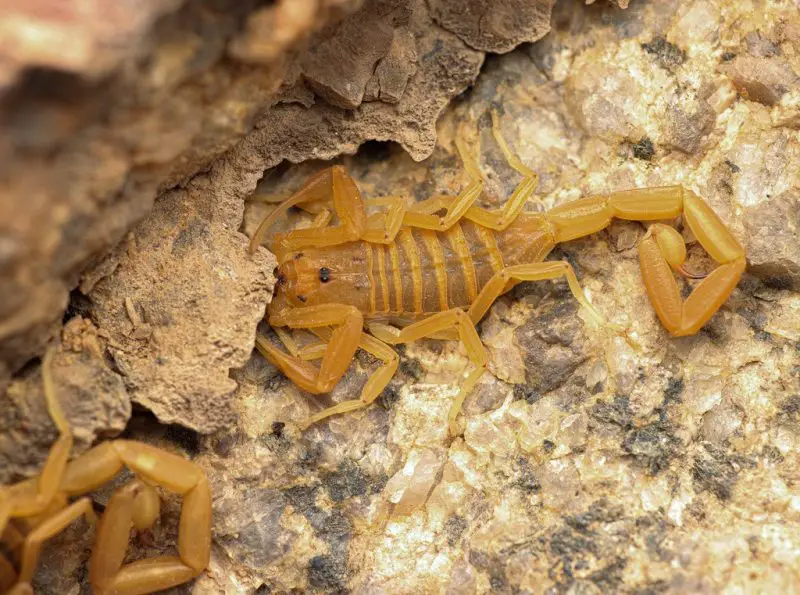
Centruroides sculpturatus, widely known as the Arizona Bark Scorpion, is the most venomous scorpion in North America. Adults can reach lengths of up to 8 centimeters and are usually pale tan or light brown in color. While native to Arizona, they are also found in parts of western Texas, particularly in areas with cottonwood and sycamore groves.
Unlike many burrowing scorpions, this species prefers to hide in crevices, under bark, rocks, and human structures. They often rest upside down, making them particularly dangerous to humans who accidentally come into contact with them when lifting objects or firewood. These scorpions are agile climbers and are known to enter homes in search of moisture and prey.
The Arizona Bark Scorpion’s venom is potent, capable of causing intense pain, numbness, vomiting, and even convulsions, particularly in vulnerable individuals such as young children or the elderly. While most stings are not fatal, severe reactions warrant immediate medical attention. Managing a sting includes cleaning the area, applying a cold compress, and using over-the-counter pain relief. Due to the variability of venom injection, caution is always advised.
Chihuahuanus globosus

Chihuahuanus globosus is a medium-sized scorpion from the Vaejovidae family, found primarily in southwestern Texas. Females of this species can grow up to 4 centimeters long. These scorpions are elusive due to their nocturnal habits, spending the daylight hours hidden under rocks, loose wood, or other debris where they can avoid predators and extreme temperatures.
Their overall appearance blends well with arid surroundings, aiding in their camouflage. Though they are not frequently encountered, they become active at night when they leave their shelters to forage for prey. Their hunting style is stealthy, using both their pincers and venom to capture small insects and other arthropods.
Chihuahuanus globosus is not considered dangerous to humans. Their sting might cause minor irritation, but they are generally not aggressive unless provoked. Their role in the ecosystem includes maintaining balance among insect populations and contributing to the region’s overall biodiversity.
Paruroctonus gracilior
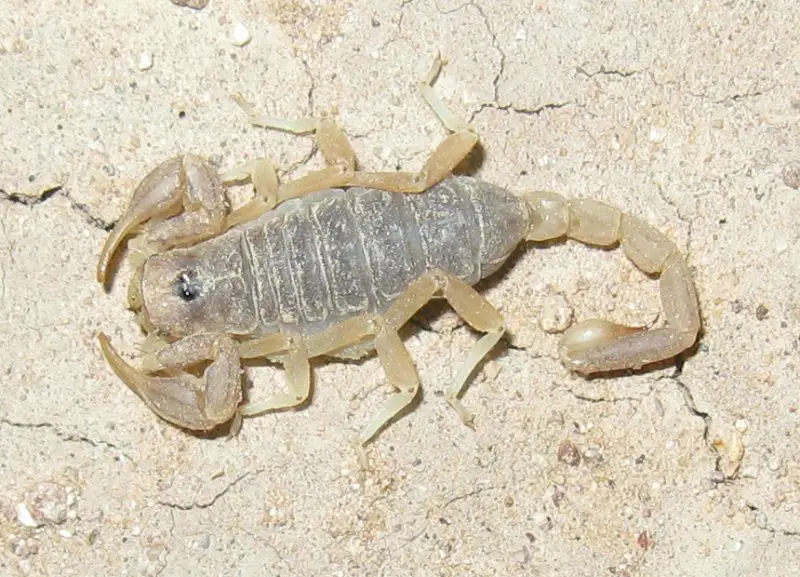
Paruroctonus gracilior is a slender-bodied scorpion in the Vaejovidae family, recognized by its elongated tail and narrow form. It ranges in color from yellow-brown to green-brown and can grow up to 4.5 centimeters long. This species is native to desert and semi-desert regions, often seen in sandy or gravelly soils of western Texas.
They are expert burrowers, usually constructing their shelters at the base of shrubs or underneath rocks. These locations provide essential protection from heat and predators, as well as proximity to prey. Their environment typically includes sparsely vegetated terrain where loose soils allow for easy excavation.
Paruroctonus gracilior feeds on a variety of small prey, including insects, spiders, and occasionally smaller scorpions. Though they are active hunters, they tend to avoid human interaction and are rarely aggressive. Their sting is not considered medically important, and they serve as effective natural pest controllers within their habitat.
Paruroctonus boquillas
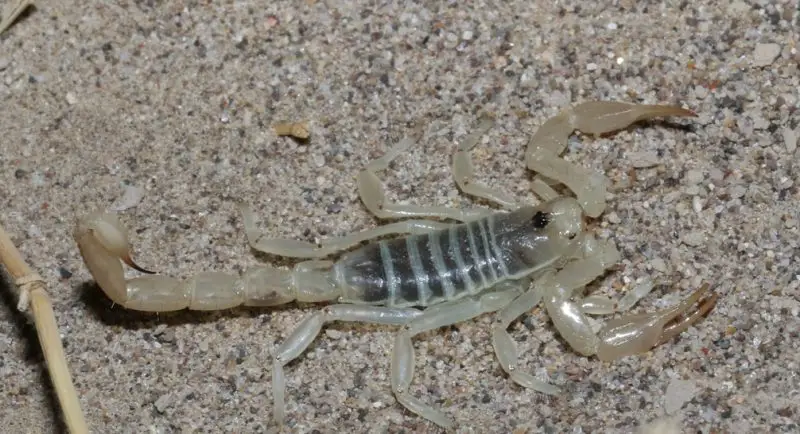
Paruroctonus boquillas is a scorpion species in the Vaejovidae family that is endemic to Texas, primarily documented within Big Bend National Park and Brewster County. Its limited distribution makes it of special interest to researchers and enthusiasts who study Texas’ unique desert fauna. This species thrives in arid regions with rocky or sandy substrates where it can remain well-camouflaged.
Sexual dimorphism is evident in this species, with females growing larger than males. Males typically reach a length of 4.9 centimeters, while females grow to about 5.5 centimeters. Despite its modest size, this scorpion plays an important ecological role in its native habitat, preying on insects and small arthropods.
Paruroctonus boquillas is nocturnal and secretive, often hiding under rocks or in self-dug burrows during the daytime. It is rarely encountered due to its reclusive behavior and specialized range, but poses minimal threat to humans, with a sting that is likely to cause only mild discomfort if provoked.






